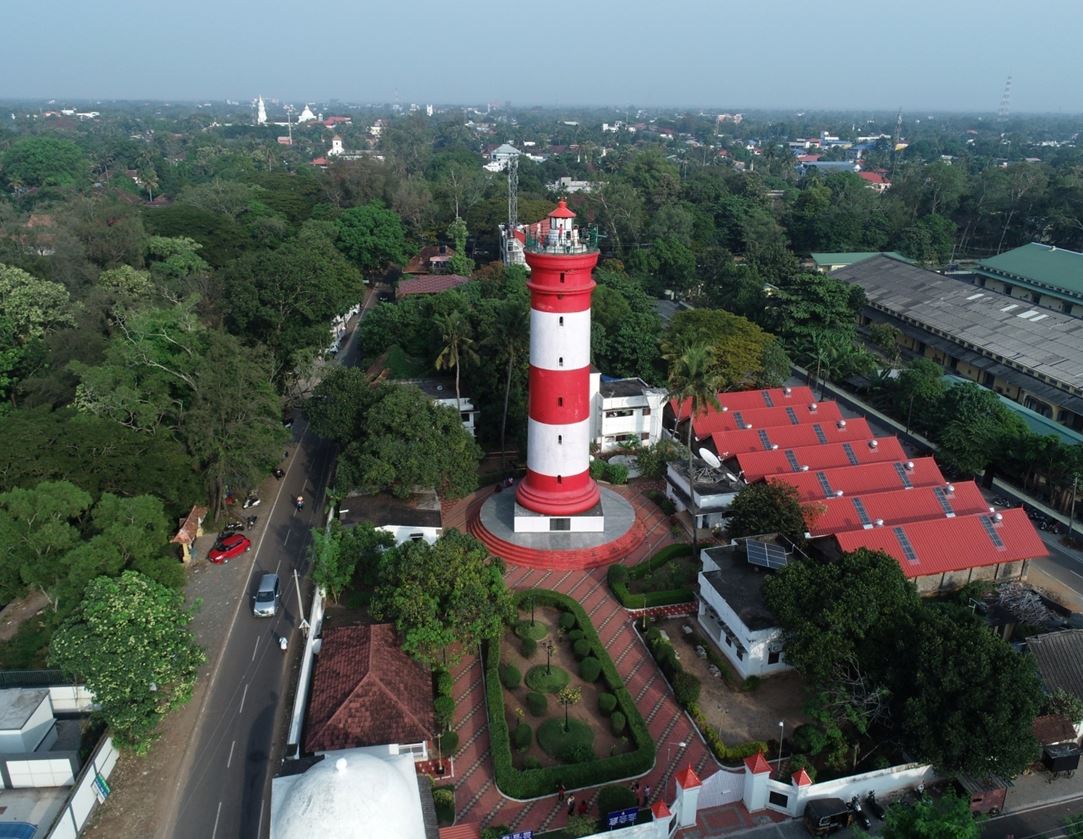Alleppey Lighthouse
IALA Heritage Lighthouse of the Year 2020 Nominee
Location: INDIA - Kerala. Alapuzha District.
Lighthouse Operator: Directorate General of Lighthouses and Lightships

Source: (photos as submitted to accompany nomination form submitted by Directorate General of Lighthouses and Lightships in 2020)
Lighthouse Description and History
| (Text extracted from nomination form submitted by Directorate General of Lighthouses and Lightships in 2020) |
| Alapuzha is the second oldest lighthouse in the west coast of India after Colaba (Mumbai). Colaba lighthouse was established by East India Company, whereas Alapuzha light was a brave effort of Travancore, a Princely state of India. The first lighthouse at Alapuzha was hoisted on the Port flag mast in 1830-35.A new stone tower and a latest lighting apparatus were proposed for Alapuzha light in 1860 and execution of work was entrusted to Hugh Crawford, then Port officer of Alapuzha. Hugh Crawford, the Scottish ex Captain had no previous experience in erection of lighthouses, but he was a man with great vision. He didn’t try to copy the shapes and construction styles of European lighthouses; instead he lent the shape of ‘QueenPawn’ in chess for his lighthouse. Best quality stones quarried from Western Ghats were used to erect the 28 meters high tower. Doors, windows and spiral stair case were made out of teak wood. The tower commissioned on 28th March 1862 is still keeping its head high as the second oldest working lighthouse in India.
The lighting apparatus installed in 1862, was a Holophotal revolving light with 9 wick lamps and it was the first flashing light in South India. Alapuzha was numerouno to have an electric light and a lighthouse museum. |
Reason For Nomination
| (Text extracted from nomination form submitted by Directorate General of Lighthouses and Lightships in 2020) |
| Intrinsic Heritage Interest of the Lighthouse
Purakkad, around 15 Km south to present Alapuzha port was one of the busiest ports in Kerala coast with a history of not less than 20 centuries. Periplus mentioned Purakkad as Burkkare. Arabs and Chinese frequently visited Purakkad in search of best quality pepper and other spices from Western Ghats. Alapuzha port was the dream project of Raja Kesavadas, the Prime minister of Travancore king Ramavarma Raja. Travancore had Colachal port near Trivandrum as their own, but it was a small port without proximity to supply lines. Quilon and Cochin ports in Travancore area were under the British control then. In a quest to have a bigger trade port under Travancore flag, Raja Kesavadas converted the marshy lands of Alapuzha to a modern port. An open sea Port was the only feasible suggestion for Alapuzha and the merchandise for export, mainly pepper and spices were to be sourced from the Western Ghats. Water transport was the only developed transport system available then at Alapuzha. To facilitate water crafts laden with pepper and spices reach directly to the port area, canals were cut to connect port with backwaters and rivers. The network of canals and roads inside the city presented this port city another name, ‘Venice of East’. After establishing the port in 1786, Alapuzha soon became the trade capital of Travancore. |
| Conservation
Developing of Cochin as an all weather port in the first half of 20th century blocked the prosperity of the open sea port at Alapuzha. By the second half of that century, port activities at Alleppey ended without leaving any scope for survival. To cope up with the situation, owners of huge transport boats converted them to House boats to receive tourists. Kerala state Government is maintaining all the canals intact for smooth running of boats and to retain the scenic beauty. Alapuzha, being a coast light, Directorate General of lighthouses and light ships continued maintenance and upgradation of lighting apparatus with all care. Apart from the tower, the 200 years old ammunition dump and the rifle shack inside the lighthouse premises also were getting periodical facelifts. The Rifle shack was converted as Light Keepers’ quarters in the start of 20th century. After construction of new residential buildings for Light Keepers in 1960, Rifle shack was modified as rest house for visiting officers and now it is a heritage guest house. |
| Public Access and Education
Along with growth of tourism in Alapuzha, the number of visitors to lighthouse also increased. Coping up with the situation, Directorate General of Lighthouses and Light ships increased the visitors’ time from 2 hours to 8 hours daily. Staircase was modified for easy access to the lantern room. Landscaping was done in lighthouse premises to increase the greenery inside and natural stone seats are provided under trees. Wash rooms and rest areas are provided for visitors. During the sesquicentennial celebrations of the lighthouse, the first lighthouse museum in India was established here inside the old ammunition dump. The 200 years old square laterite stone structure with a semi spherical dome top was thoroughly modified to accommodate the museum that has a variety of exhibits. The original holophotal lighting apparatus used at Alapuzha in 1862 was brought back from our Kolkata Optical lab and fitted inside the museum in a grand style. Along with this, different types of lamps, gas flashers, sun valves, drum optics, lamp changers and a big Pedestal rotating beacon are exhibited with trilingual information boards. The museum will present general public and students an overview about of evolution of lighting apparatuses and lamps during the last two centuries. Guides are always ready to explain the visitors about the history of this lighthouse and pass on general information about the other lighthouses in India and other parts of the world with a smile. |

